The courageous Party has been pushed to the brink of its abilities. The gloomy dungeon has left them with nary a potion or spell slot to their name. The night might be dark, but the lush greenery is a welcome sight. It might be full of needles and vines, but surely those twitching twigs are signs of friendly woodland creatures crawling about.
Lowering your guard is the Blight of safe sleep. There is a chance those shrubs are sapient. Better them than the trees! As you’ll surely see.
Blights are a notable species of plant monster that can give your tale of corruption and chaos a green, lush edge. Needles, Twigs, and Vines might seem like hardly a challenge, but the danger is not understanding their source.
Mandrakes aren’t the only plant with their roots buried in vampiric lore. So let’s talk necrotic botany.
Welcome to a Blight 5e Guide.
Breaking Blights Down
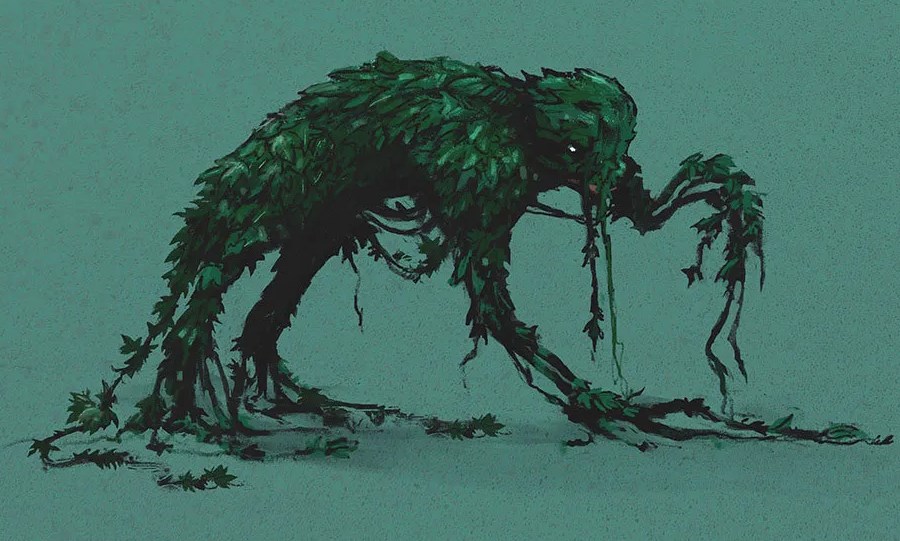
Book: 5e Monster Manual, 5e Curse of Strahd
The appearance of a blight indicates a source of corruption in the infected forest. Blight plants are born from the infectious roots of a Gulthias Tree, a tree corrupted by a particularly powerful supernatural soul. From this tree, the soil and roots of the surrounding vegetation become corrupted.
Plants taken over by this corruption began to take on the rough visage of the supernatural soul in question. Like corrupt topiaries, these plants are merely fragments of a once whole being. The vines speak in their voice, the twigs act as wily as they did in their prime, and the conifers convey and patrol as their minions once did.
This is what happens when you don’t salt the land and cleanse the air after you stab that vampire or necromancer in the heart. So always properly dispose of your Big Bad Evil Corpses. Otherwise, your campaign’s most significant victory might spoil into a Gulthias Tree, Blight of the nearest village.
- Blights are considered independent and sapient. However, their whims are manipulated by a Gulthias tree.
- The official blights are Twig, Needle, and Vine. More based on other plant types are available as homebrewed creatures.
- A Guthias Tree is typically born from a staked vampire’s blood infecting the wood of the fatal stake, causing it to take root.
- A powerful evil mind or soul can also birth a Guthias Tree upon death.
- The personality of the soul that grew a Guthias Tree will affect the motives of the blights born from the roots it weaved itself into.
- As a Guthias’ Tree’s corruption spreads into the roots and soil, healthy plants will turn into blights.
- Blights will further cause healthy plants to become corrupted into brambles, toxic weeds, thorny vines, and nearly-dead bushes.
- As the only ‘dry plant’ of the bunch, only Twig blights have a vulnerability to fire.
- Twig Blights are ambush predators, encircling natural gathering spots in groups while pretending to be shrubbery.
- Needle Blights are ranged enemies that seek to surround their target like a firing squad.
- Vine Blights are roguish tanks seeking to surprise a party with a mass of entangling roots.
- Blights are vampiric in origin. Their bloodthirst proves it.
- Blights ain’ bright alone, but a well-tended Gulthias Tree can turn the harvest into an army.
- A Gulthias Tree will regain 1 hit point a month until fully healed unless uprooted from the soil.
Greedy Gulthias Trees
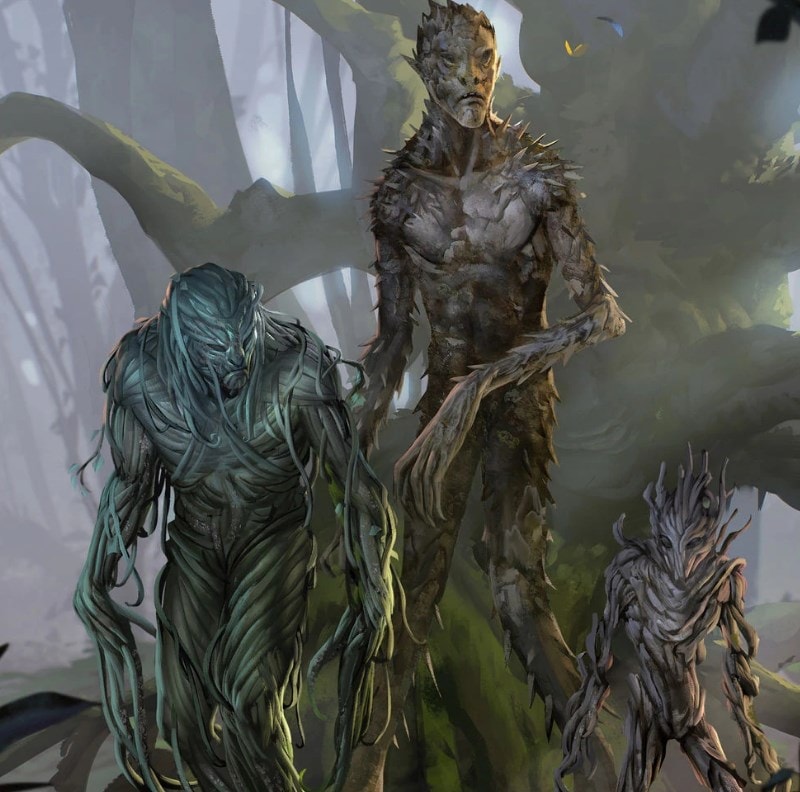
- Source: Chapter 14: Yester Hill.
- AC: 15
- Hit-points: 250
- Dmg Immunity: Bludgeoning, Piercing, and Psychic damage.
- Exp: 1,500
While blights have many sources across Faerun these days, Gulthias Trees are the most reliable ways to cultivate a plentiful harvest of Blights.
A Gulthias tree is a tree infused with supernatural evil that can create blights. This can be done either through the seeds it produces or via corrupting other plants affected by its root system. The Gulthias Tree can act as the source of an infection capable of infecting an entire forest.
Plant Posse
As mentioned in CoS, the average Guthias Tree is surrounded by three vine blights, six needle blights, and twelve twig blights. Blight stats are included in the sections below.
Should the DM find this too easy for their Party, one or two tree blights will turn this swarm into a monster mash capable of handling only the most worthy Player Parties.
Difficult Death
The creature possessing a Gulthias Tree learned to be stubborn in death. Merely reducing its HP to zero or below isn’t going to cut it in this forest.
A Gulthias Tree is never entirely dead unless you cull the infection from the entire root system, mushrooms and all.
However, a Dc 15 Int (Nature) is required for an adventurer to realize that the entire stump and its deep roots must be removed to clear the Blight.
Failure to properly kill a Gulthias Tree will slowly recover at the rate of 1 hit-point every month. Once fully healed, the tree will resume its blight-related activities.
Twig Blight

Small Plant, Neutral Evil
CR ⅛ (25 XP)
- Passive Perception 9
- AC: 13 (natural armor) Hit Points: 4 (1d6+1)
- Speed 20 ft
- Str 6 (-2) Dex 13 (+1) Con 12 (+1)
- Int 4 (-3) Wis 8 (-1) Cha 3 (-4)
- Skills: Stealth +3
- Dmg Vuln: fire
- Con Imm: blinded, deafened
- Senses: blindsight 60 feet
- Languages: A twig blight can’t speak, but they understand common.
False Appearance
If the Blight remains motionless, it looks no different from a dead shrub or sad sapling.
Actions
N/A
Claws
- Roll to Hit: +3
- Range: Five Feet, Single Target
- Hit: 3 (1d4+1) piercing
A Twig Blight looks like Marvel’s Baby Groot.
To be less cheeky, Twig Blights will hide their humanoid form by rooting themself in the soil while unweaving to resemble mere shrubs.
To move and function in combat, the twigs will weave themselves back together to take on the appearance of a twiggy humanoid. It will try its best to create a head and limbs, though it is the least capable of the blights in the skill of resembling a human.
Unfortunately for the Twigs, they are the least hydrated of the blights. As a result, they are the only Blight to be particularly vulnerable to fire, which is incredibly unfortunate for something that likes to pretend it’s a bundle of firewood on a campsite.
Twig Tactics
Understanding themselves as the weakest grunts of the Gulthias Tree’s army, Twig Blights are patient and hunt in packs. They lie in wait, banking on an adventurer’s disregard for the suspicious nature of plant life.
Campsites, watering holes, and trailheads are the perfect bait for a Twig Blight. Multiple twigs will gather around these points, blending in like a mimic specializing in twig bundles. They easily mimic the natural vegetation of their chosen area, made easier by a blight’s tendency to corrupt the plantlife around them in the faint, corrupted image of the Gulthias Tree’s specific theme.
They then wait for the Party to be at their most vulnerable before they rapidly spring into action. Then, where they might be weak individually, they make up for it in numbers. A single thorned rose is upsetting, but being beaten down by the entire rose garden is a death sentence.
Needle Blight
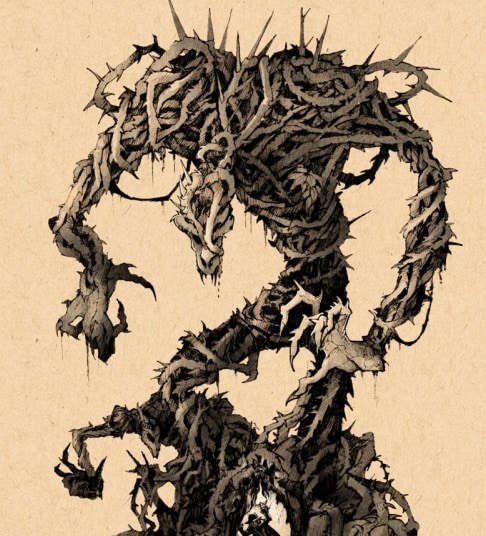
Medium Plant, Neutral Evil
- CR ¼ (50 XP)
- Passive Perception 9
- AC: 12 (natural armor) Hit Points: 11 (2d8+2)
- Speed 30 feet
- Str 12 (+1) Dex 12 (+1) Con 13 (+1)
- Int 4 (-3) Wis 4 (-3) Cha 3 (-4)
- Con Imm: blinded, deafened
- Senses: blindsight 60 feet
- Languages: A needle blight can’t speak, but they understand common.
Actions
———————————
Claws
- Roll to Hit: +3
- Range: Five Feet, single target
- Hit: 6 (2d4+1) piercing
Needle
- Roll to Hit: +3
- Range: 30/60 feet. Single Target
- Hit: 8 (2d6+1) piercing
———————————
Needle blights notably lack the False Appearance skill, the least stealthy of the bunch. Needle Blights almost look like aquatic, thorny beings more than a plant. Their floral nature cannot be mistaken with a close glance. Particularly if it flings its needles at you.
From afar, and thanks to their ranged capabilities, this will be their preferred distance; they can easily be mistaken for hunched humanoids. So they shuffle through the bushes. They are not too worried about hiding their presence, thanks to their large demeanor.
They rather function as the Gulthias Tree’s patrolling guard.
Needle Tactics
A needle blight prefers to use its conifer-like needles, though it can claw any who get too close. Its claws are a degree of damage lower than its ranged attack. The actual danger, as will all blights, are their hidden numbers.
When a patrolling Needle blight detects a threat, it will release unique pollen to alert all Blights downwind and attract other Needle Blights to its position.
These Needle Blights will then seek to surround and ambush the target while peppering them with a devastating onslaught of needles from all sides. Including an aerial assault should its commanding Gulthias Tree be wily enough.
Vine Blight
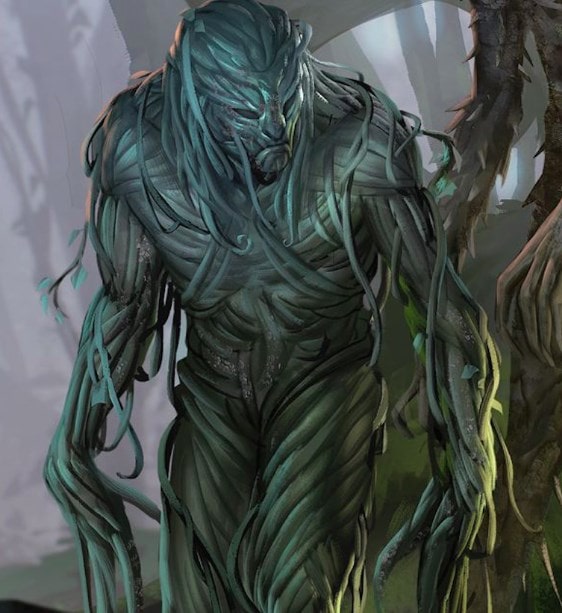
Medium Plant, Neutral Evil
- CR ½ (100 XP)
- Passive Perception 10
- AC: 12 (natural armor) Hit Points: 26 (4d8+4)
- Speed 10 ft
- Str 15 (+2) Dex 8 (-1) Con 14 (+2)
- Int 5 (-3) Wis 10 (0) Cha 3 (-4)
- Skills: Stealth +1
- Con Imm: blinded, deafened
- Senses: blindsight 60 feet
- Languages: Can’t speak, understands Common.
———————————-
False Appearance
If the Blight remains motionless, it looks no different from a dead shrub or sad sapling.
Actions
———————————
Constrict
- Roll to Hit: +4
- Range: Ten Feet, Single target
- Escape DC: 12
- Hit: 9 (2d6+2) bludgeoning
Grapple: Only one target can be grappled. If hit, a large or smaller target is immediately restrained until the Escape DC is met.
Entangling Plants
- Recharge: 5-6
- Duration: 1 minute. One round = 6 seconds, so 10 rounds.
- Save: 12 DC Str. Also counts as Escape DC if a target is grappled.
- Range: 15-foot radius, any targets the Blight chooses.
Targets are considered restrained unless the save DC is succeeded.
Grasping roots and vines sprout in the area centered on the Blight. Nonplant creatures consider the affected area ‘difficult terrain.’
The Vine Blight has the appearance of a grumpy, long ‘haired’ humanoid. In reality, it is a pillar of entangled roots. Its features are formed from the folded patterns of the threaded vines. Their body is far more refined and patterned than the shambling mound.
Frighteningly, these are also the only blights capable of responding to speech rather than just nodding dumbly. This makes the figure beckoning you deeper into the clearing seem all the more human.
Its voice mimics the evil spirit corrupting the local Gulthias tree, thought fractured and corrupted. It mostly just sasses weaker targets while trying to bargain with those outclassing it, like some sort of two-bit hag.
Vine Tactics
Much like a twig blight, their vine-infested cousins like to patiently lie in wait. But, unlike the twigs, they will space themselves out as they can command the plant life surrounding them to act as their allies.
The deadliest of the official blights, they function as an Entangling roots spell with stealthy spite. A vine blight likes to hide in the corrupted overgrowth, blending and letting an entire party get within their 15-foot radius before sicking the surrounding plants on a party.
It will use its ability to mimic its progenitor by using intimidation, charisma, or antagonism to lure adventurers into the clutches of its own personal plant pile or into a far large, strangely calculated blight ambush.
Tree Blight

Huge Plant, Neutral Evil
- CR 7 (2900 XP)
- Passive Perception 10
- AC: 15 (natural armor) Hit Points: 149 (13d12+65)
- Speed 30 ft
- Str 23 (+6) Dex 10 (0) Con 20 (+5)
- Int 6 (-2) Wis 10 (0) Cha 3 (-4)
- Con Imm: blinded, deafened
- Senses: blindsight 60 feet
- Languages: The tree blight might not speak, but it understands Common and Druidic.
False Appearance
If the Blight remains motionless, it looks no different from a dead shrub or sad sapling.
Siege Monster
A Tree Blight is a massive Kaiju of a monster. It deals double damage to objects and structures. Think of how a falling tree can decimate a house, then give it legs.
Actions
———————————
Multiattack
The Blight has the potential to make five attacks in one turn. First, it can use two Branch attacks, two Gasping Roots attacks in a single action, and finally, a Bite attack as a bonus action.
Bite
- Roll to Hit: +9
- Range: Five Feet, Single Target
- Hit: 19 (3d8+6) piercing
Branch
- Roll to Hit: +9
- Range: Fifteen Feet, Single Target
- Hit: 16 (3d6+6)
Grasping Root
- Roll to Hit: +9
- Range: Fifteen Feet, single target not being grappled by the Tree Blight.
- Escape DC: 15
Hit: Target is immediately grappled. Until the target can succeed in the Tree Blight’s Escape DC, they will take 9 (1d6+6) bludgeoning. This will repeat at the start of the target’s turn until they escape.
Root Ac: 15
A Root can be severed by chipping at its AC or managing to land 6 points or more of slashing damage in a single root. This does not damage the Blight but will release the target from its grapple.
Where a Twig Blight is Baby Groot, a Tree Blight is a hulking behemoth of bark and moxy, with a web of spidering roots branching out in place of legs. Its upper body could pass for a human statue made of wood if a tree had decided to continue growing from it.
Tree Blights are found in the 5e adventure book Curse of Strahd. They are the strongest of all the Blight I personally found, with a hefty 7 challenge rating.
A Tree Blight bears the closest resemblance to their new master. Only, they resemble their current state as a Guthias Tree most. There is only a faint resemblance of their past warped in the bark.
Due to the power and corruption required to brew a Tree Blight compared to its weaker cousins and their status as the most battle-ready of the blights, most Tree Blights can be found expanding their host’s territory. However, should the host tree be powerful enough to afford the plant power, one or two might be lumbering around their infectious host.
Unlike a Twig Blight, a Tree Blight is not vulnerable to fire. While twigs are kindling, a tree’s bark and botany make it less susceptible to being one massive campfire than its weaker cousins.
Tree Tactics
Tree Blights disguise themselves as lumbering trees, found in more significant numbers the closer you draw to their host. Thanks to their power, weaker species of blights will often swarm around them for protection while acting as chip-away backup. A Tree Blight, along with a small army or Twig Blights, is a likely sign you are near the source of corruption.
To solidify their spread, a Guthias Tree might send individual Tree Blights out to stake out the corners of their infested forest. Thus making it that much harder for all but the most powerful adventurers to take on the brunt of a wild whomping willow.
A Blight Bushwack

A single Twig Blight is likely to be snapped like the nuisance it is if it strikes alone. Therefore, a DM would better flex their tactical muscles by using their variants to keep the Party on their toes.
A forest infested by a Guthias Tree will have very few safe spots to camp. Those spots you assume are safe and sound are home to a group of highly spiteful bushes.
They are patient tumbleweeds, though. They instead strike once the Party has drifted to sleep. Preferably once a Needle Blight has brought it to the attention of any blight downwind.
Soon the Party has a rain of needles tearing their tents apart, twigs intent on clawing at their shins, and a bed of vines conducting the surrounding root system to hold you in place.
Then, just when your Party thinks they have the situation under their control, the tree the Rogue had been sleeping in stands up.
The First Blight Infestation
There is a very unique method of birthing a Gulthias Tree through the legend of its namesake. Said to be the first instance of Blights infecting any forest in the Forgotten Realms.
Gulthias of Nightfang Spire was a vampire so powerful that not even staking him properly cleansed the world of his scourge.
In fact, the stake began to sprout into a vampiric sapling. Gulthias’ corpse began to corrupt that spike of wood into potential, but it was the misguided love of a deranged druid that made the first Gulthias Tree take root.
This druid is said to have transplanted the tree to an underground grotto, making it obnoxiously hard to find by later adventuring parties. This druid nurtured the necrotic tree into blossoming the first blights.
After this event, more Gulthias trees began to pop up across the forgotten realms. Likely the abominable creation of fallen vampires. Mystra clearly found this amusing and played around with the idea. Mistress of Magic always admires a good idea, regardless of its alleged alignment.
Old Ornery Obstacles
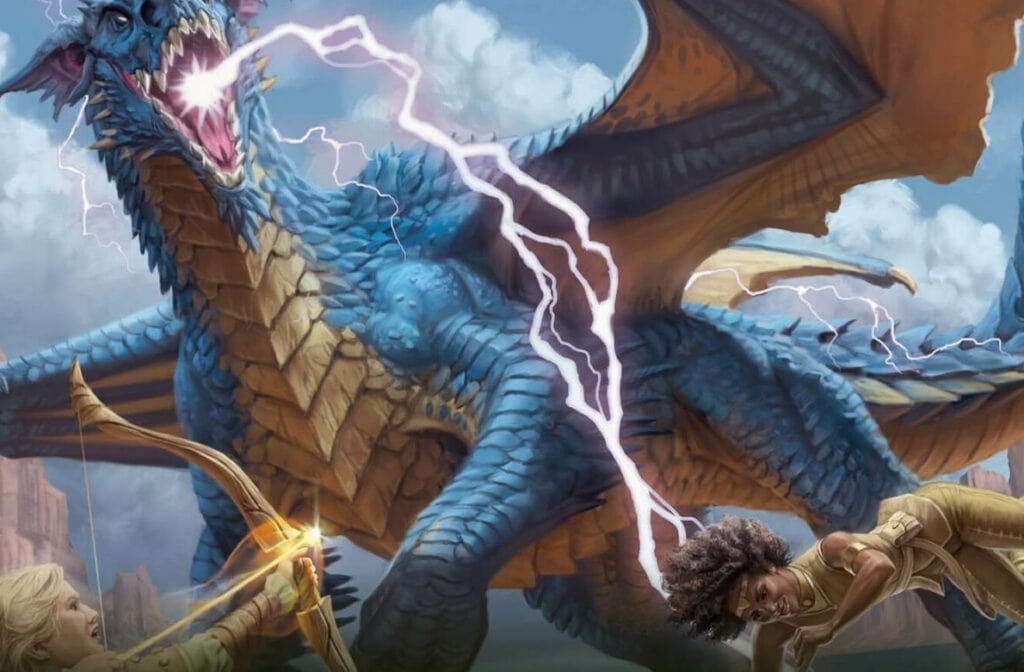
While the first Gulthias Tree, and its namesake, were vampiric in origin, that does not mean the DM is shackled to the idea. On the contrary, while the Gulthias Tree being a used vampire stake given root is a fascinating one, there is plenty of usage for a DM.
The lore of a Gulthias Tree implies an evil soul determined enough to conquer death can possess a tree into a Gulthias Tree. If you want to make it harder for your villain, you can even require their minion to take on the role of the ‘Mad Druid’ mentioned in the same lore.
A mixture of dying spite and a loyal druidic right hand can create a Blight Corruption from your Party’s greatest enemy. Adding a Tree Blight can up the ante and thoroughly test their merit, giving the Party one last battle after settling in for their epilogue.
The final adventure could be ridding their famous village of a blight infestation months after they cleansed the world of the Big Bad Evil Goon. This infestation can give all their favorite NPCs a chance to poke their head in and give them a final peek at what all their work had inspired.
The village is saved with a final bash cleansing the forest of an old enemy. Ending the campaign with the ashes of a Gulthias Tree and its Blight.
FAQs
Question: What is the spell Blight in Dnd 5e? Is it related to the Gulthias Tree?
Answer: Blight is a 4th-level Necromancy spell. It is available to Druids, Sorcerers, Warlocks, and Wizards. It deals 8d8 Necrotic damage on a failed Con save, with half damage dealt on a success.
Plants are particularly susceptible to the effects of Blight. Plant Creatures and magical plants hit with Blight take the total 64 damage, 32 on a successful save. Nonsapient, nonmagical plants are granted no save and instead wither and die when subjected to Blight’s energy.
While not directly related to the Blight species nor the Gulthias Tree, an item enchanted with a Blight spell would make for a beautiful prize at the end of a long adventure full of sapient bushes. For example, an item constructed using the wood of a Guthias Tree could easily be the excuse to create the plant withering Blight Blade.
Question: Is there any way to make my Gulthias Tree more intimidating for my 5e DnD Campain?
Answer: The Gulthias Tree in canon lore has no effective action of its own besides acting as the hive mind for the Blight infection. However, should you want to make the Gulthias tree encounter more exciting, you can add or replace the AC, hit-points, Dmg Immunity, and Experience listed above with a creature that you think best suits your campaign. The Tree Blight is a perfect monster to use. However, other options include a dryad, treant, or wood woad.
Conclusion
Blights are an often overlooked creature available to Dungeon Masters. They can both replace the typical ‘rats in a cellar’ trope with a more whimsical dash of fantasy as individual nuisances and ruin the day of a pack of 5th levels should the Gulthias Tree lead them to have a vindictive motive against them.
A Blight infestation is easy to throw together as a quick on-off headache, should goblins and cellar rats be a bit cliche for you. The Gulthias Tree will give you a more profound explanation should your Party go off the rails.
One of the best experiences a party can experience in Dungeons and Dragons are those tidbits and spots of lore that get them raising questions. Should you have a complete answer or not as a DM, this Blight Guide will at least keep you covered if they start inquiring about the origins of the twitchy Twigs.
The answer can’t always be Fey in nature, even if a Hag can just as likely be used as the source from a Blight.
- Blight 5e Guide: Blood-Thirsty Brambles - August 28, 2022
- Constructs 5e Guide: Intimidating Innovation - August 20, 2022
- Modrons 5e Guide - August 13, 2022

